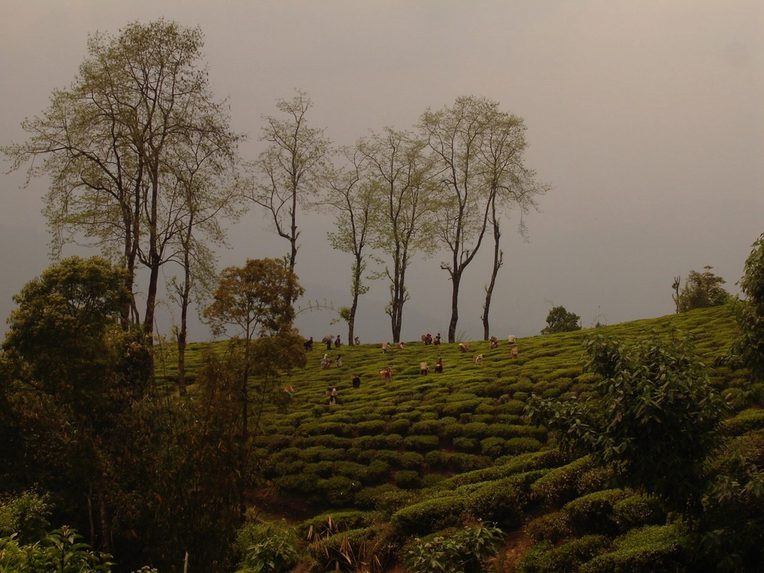Monoculture
From the Series: Lexicon for an Anthropocene Yet Unseen
From the Series: Lexicon for an Anthropocene Yet Unseen

Agriculture—or more accurately, horticulture—marks human settlement. Growing plants is both a means of making place and a reason to stay there.
When agriculture reaches for economies of scale, plants become plant; think of the singularized nouns soy, cotton, and rubber. In monoculture, both botanical varietals and variety in the landscape disappear. Champions of imperial expansion hailed monoculture as a triumph of science and technology over putatively wild landscapes and people. In this respect, tea was prototypical. Indian-grown tea, along with other colonial monocultures like sugar, coffee, and tobacco, formed an arsenal of “proletarian hunger-killers” (Mintz 1979, 60)—cheap energy that fueled the early carbon-based economy of British and American mills.
How do you make a monoculture?
The anonymous author of a nineteenth-century instructional text (Tea Cultivation 1865) for would-be tea planters outlines the precise steps that need to be taken.
“Tea will grow better in virgin soil,” the text explains. “Village lands have long ago had all of the goodness taken out of them . . . The germs of all kinds of seeds deposited by animals, wind, people” sap the “strength” of this “formerly cultivated” soil. Such soils, we learn, require five times as much labor “to keep.”
In the more distant forest, the text goes on, “the wind has less power to deposit on the surface seeds of wild grasses, and perhaps, more than all, no manure (always so fruitful in the propagation of weeds) has been spread onto the land.”
How best to clear these forests and “jungle lands”?
To get all of the life out of a forest, you must be methodical. First, you should cut the bamboo, grasses, and small trees, leaving them on the ground to dry for two to three months, rendering them into kindling. Next, bigger trees can be removed by ringing, or carving a six-inch to two-foot circle of bark around the trunk. Sap circulates under tree bark like blood under our skin. Ringing halts this process by choking the vascular flow of nutrients to the upper reaches of the tree—a slow death.
Anticipating the would-be monoculturalist’s concerns about the time and cost of eradication, the manual warns about the dangers of the alternative: unchecked biological diversity. White ants make homes in large trees, and they quickly shift to chewing on the bases of tea bushes if those trees are not ringed.
Once trees and grasses have dried up, it is time to burn. The manual continues:
It is a grand sight to see—the fire leaps along, urged by a strong wind, which is generally waited for, and the quantity of combustible material is so great that the moderate sized trees, which have been felled and which would not burn themselves, are completely consumed. A curious accompaniment to these fires is the sound emitted by the burning bamboos. It resembles incessant discharges of musketry. As I lay in bed one night, in the neighborhood of a blazing jungle, I might easily have fancied myself in action; in fact I did fancy so; for as sleep stole over me, the volley upon volley transported me to scenes far different from the evergreen tea gardens around.
The military overtones are apt. They are flashbacks, of course, but also flash-forwards to a contemporary moment when voracious forest fires consume human and nonhuman life from California to Indonesia and fires in unregulated sweatshops undermine capital’s efforts to produce cheaper and cheaper goods. Monoculture requires eradicating life, even though monocultures are often formed in the name of feeding or otherwise sustaining life.
How do you maintain a monoculture?
The plantation is the system that keeps the ants, grasses, and trees at bay. Plantation work goes on year after year, in the form of burning and replanting (in the case of annual crops like sugar, cotton, and soy) or pruning and watering (in the case of perennials like tea and coffee). Plantation work is equal parts caring and killing: pesticides and fertilizers, spades and sickles, irrigating water and combustible fuel.

Monoculture sutures people’s identities to single things. Today, in the tea districts of Assam, plantation workers are referred to as “tea tribes.” Although Indian tea plantation workers are technically free to abandon the fields to seek work in cities or towns, workers receive the bulk of their compensation not in cash but in kind, in the form of housing, food rations, and medical facilities. This system of in-kind payment ensures that the reproduction of human life is woven firmly into the continued production of tea. Since plantation monoculture is an economy of scale, people and plants only need to be marginally healthy, marginally alive. Quantity of life comes before quality of life.
The consignment of certain kinds of persons to dependence on monoculture continues, but botanical homogeneity is also being pursued in the name of cultural homogeneity: mono-culture. The things that inhabitants of the industrialized North cannot live without—coffee, tea, sugar, bananas, as well as the rubber in our tires, the soy that binds dark chocolate, and the grasses that cover suburban lawns—are mono-cultured. Single-species landscapes are among the most vulnerable to blights, diseases, and droughts. Frequently, the answers to this vulnerability come from biotechnology: pesticides and genetic modification have helped expand monocultures as never before, often with deadly results not just for insects and weeds but for people (Hetherington 2013).
The violence of the Anthropocene lies in its monotone nature. The illusion that there is a single we that desires coffee, sugar, soy, and rubber can lead to the illusion that the planetary costs of these technical quick-fixes affect us all equally. Monoculture’s power, then, is its ability to breed not just a dearth of biological difference across landscapes, but a creeping in-difference to the radically uneven impact of capitalism on ecologies, identities, and planetary life. Such indifference may be the greatest threat to life in the Anthropocene.
Hetherington, Kregg. 2013. “Beans Before the Law: Knowledge Practices, Responsibility, and the Paraguayan Soy Boom.” Cultural Anthropology 28, no. 1: 65–85.
Mintz, Sidney W. 1979. “Time, Sugar, and Sweetness.” Marxist Perspectives 2, no. 4: 56–73.
Tea Cultivation. 1865. Calcutta: Military Orphan Press.